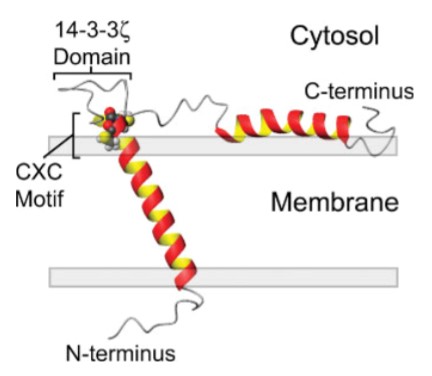With rich experience in membrane protein production for years, Creative Biostructure, with our scientific elites, can produce custom stannin by applying our advanced and leading platform-Mempro™ cell-based expression systems.
Stannin (SNN) is a small membrane protein that is remarkablely conserved. Researchers have identified stannins in a broad range of organisms among all vertebrates. Stannin contains an unstructured linker, a single spanned transmembrane helix, and a cytoplasmic helix. There is a metal binding motif CXC (Cys-32 and Cys-34) resided on the interface between lipid and solvent, interacting with organotin compounds specifically. Residues 39 to 45 of stannin was unstructual and assumed as the 14-3-3 binding domain, which is distant to the conserved metal binding motif CXC; while the linker domain is structural and dynamic. Furthermore, stannin C-terminal helix is strikingly divergent among species, which binds to the lipid bilayer to interact with other targets in cytoplasmic domain. The major function of stannin is the mediation of organotin toxicity. In consideration of the highly-conserved sequence of stannin, why and how this mitochondria located membrane protein regulates growth and apoptosis with other proteins is still unknown.

• Mempro™ Stannin Production in Bacterial Cells System
Escherichia coli (E. coli) is the most used bacterial host for membrane protein production. Generally, we provide two strategies to produce membrane proteins in E. coli system, insertion of the soluble membrane protein into the cellular membrane, or cytoplasmic aggregation as inclusion bodies (IBs). We also provide production protocol optimization services for your specific target.
• Mempro™ Stannin Production in Mammalian Cells System
Mempro™ membrane protein production in mammalian cells system is also one of our membrane protein production systems. This system can deliver native membrane proteins with correct folding and post-translational modification. A broad range of mammalian cell types are used as membrane protein expression host including BHK-21, CHO, COS-7 and HEK-293, etc.
• Mempro™ Stannin Production in Yeast Cells System
Mempro™ membrane production in Yeast expression system is one of the microbial systems. Our yeast cells system is an attractive host due because of single cells, inexpensive media, fast growth rates, and high cell densities.
• Mempro™ Stannin Production in Insect Cells System
The baculoviruses are popular applied for eukaryotic membrane protein production. Compared to E. coli system, Mempro™ protein production using insect cells system can not only increase the expression level but also reduce the truncated proteins
Creative Biostructure has overcome various membrane protein production barriers by optimizing the expression vectors, growth conditions, host strains, co-expression of helper proteins and fusion tags, etc, and we are capable of producing high-quality and high-yield stannins.
We offer various Mempro™ membrane protein production services. Please feel free to contact us for a detailed quote.
References:
M.L. Billingsley, et al. (2006). Functional and Structural Properties of Stannin: Roles in Cellular Growth, Selective Toxicity, and Mitochondrial Responses to Injury. Journal of Cellular Biochemistry., 98: 243-250.
B. A. Buck-Koehntop, et al. (2005). Structure, Dynamics, and Membrane Topology of Stannin: A Mediator of Neuronal Cell Apoptosis Induced by Trimethyltin Chloride. J. Mol. Biol., 354, 652–665.
S. Haga, et al. (2002). Neuronal degeneration and glial cell-responses following trimethyltin intoxication in the rat. Acta Neuropathol, 103: 575–582.
